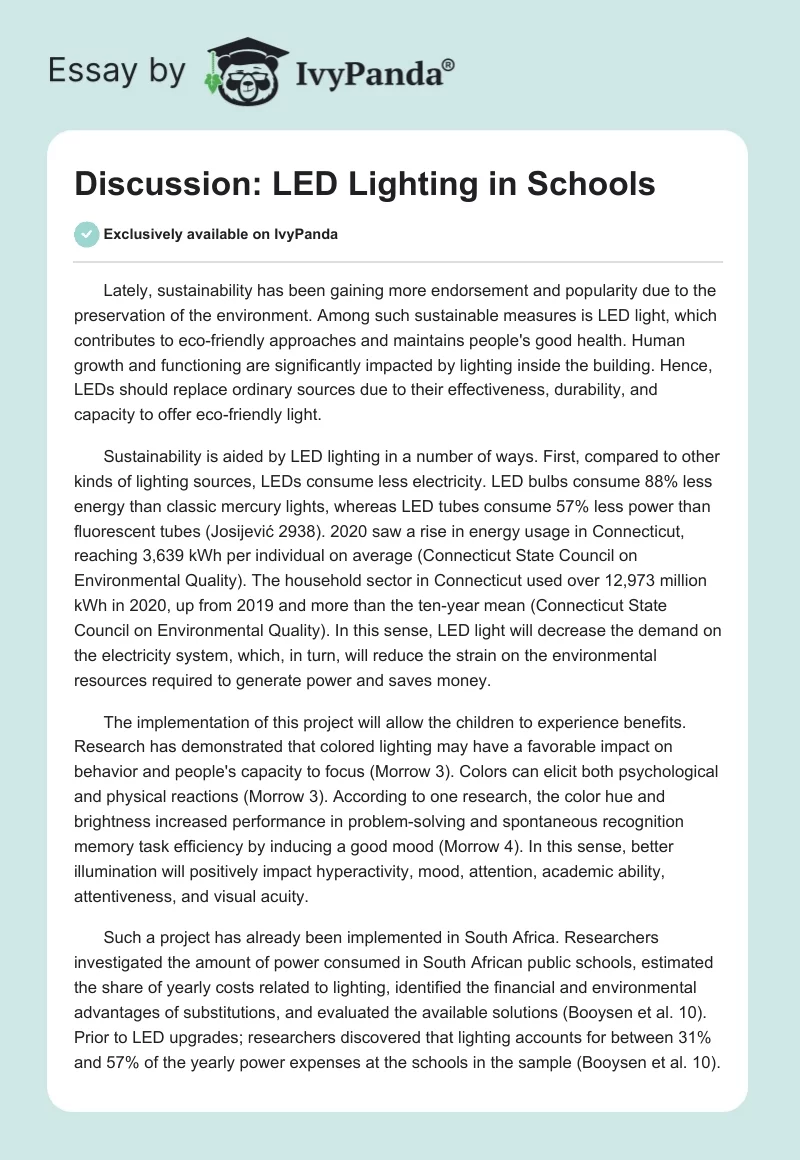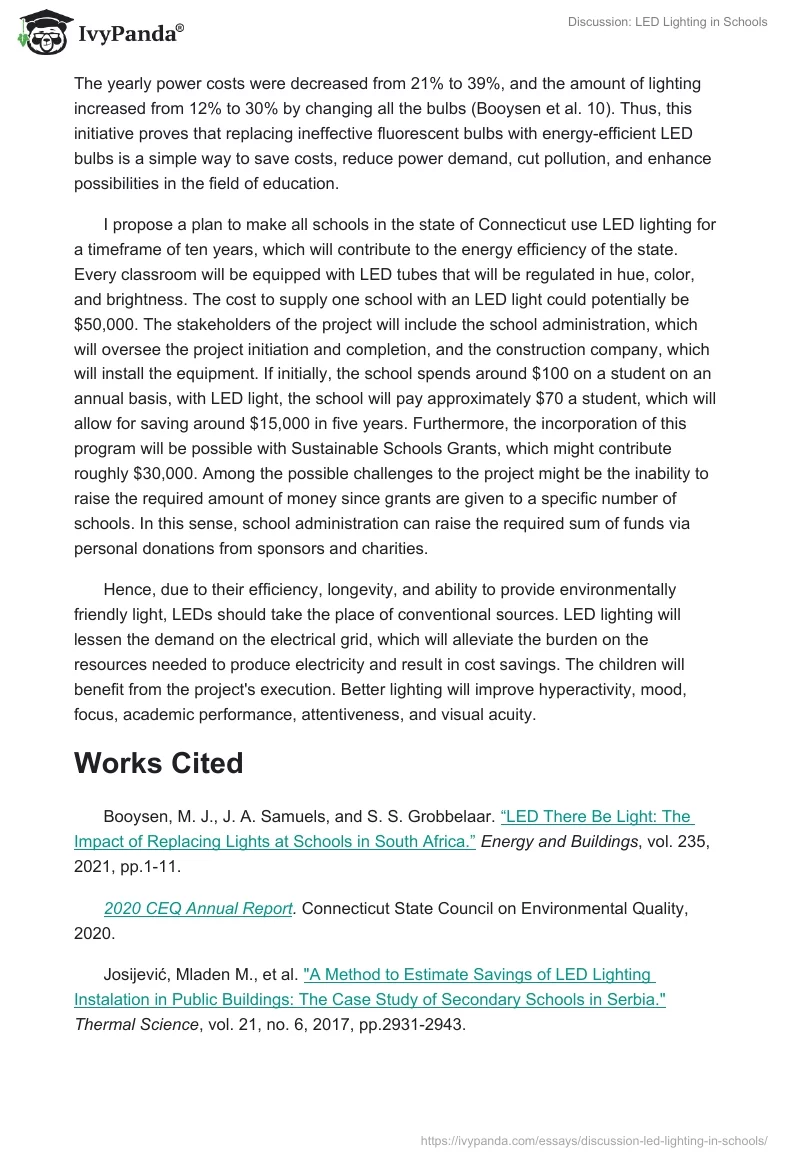Lately, sustainability has been gaining more endorsement and popularity due to the preservation of the environment. Among such sustainable measures is LED light, which contributes to eco-friendly approaches and maintains people’s good health. Human growth and functioning are significantly impacted by lighting inside the building. Hence, LEDs should replace ordinary sources due to their effectiveness, durability, and capacity to offer eco-friendly light.
Sustainability is aided by LED lighting in a number of ways. First, compared to other kinds of lighting sources, LEDs consume less electricity. LED bulbs consume 88% less energy than classic mercury lights, whereas LED tubes consume 57% less power than fluorescent tubes (Josijević 2938). 2020 saw a rise in energy usage in Connecticut, reaching 3,639 kWh per individual on average (Connecticut State Council on Environmental Quality). The household sector in Connecticut used over 12,973 million kWh in 2020, up from 2019 and more than the ten-year mean (Connecticut State Council on Environmental Quality). In this sense, LED light will decrease the demand on the electricity system, which, in turn, will reduce the strain on the environmental resources required to generate power and saves money.
The implementation of this project will allow the children to experience benefits. Research has demonstrated that colored lighting may have a favorable impact on behavior and people’s capacity to focus (Morrow 3). Colors can elicit both psychological and physical reactions (Morrow 3). According to one research, the color hue and brightness increased performance in problem-solving and spontaneous recognition memory task efficiency by inducing a good mood (Morrow 4). In this sense, better illumination will positively impact hyperactivity, mood, attention, academic ability, attentiveness, and visual acuity.
Such a project has already been implemented in South Africa. Researchers investigated the amount of power consumed in South African public schools, estimated the share of yearly costs related to lighting, identified the financial and environmental advantages of substitutions, and evaluated the available solutions (Booysen et al. 10). Prior to LED upgrades; researchers discovered that lighting accounts for between 31% and 57% of the yearly power expenses at the schools in the sample (Booysen et al. 10). The yearly power costs were decreased from 21% to 39%, and the amount of lighting increased from 12% to 30% by changing all the bulbs (Booysen et al. 10). Thus, this initiative proves that replacing ineffective fluorescent bulbs with energy-efficient LED bulbs is a simple way to save costs, reduce power demand, cut pollution, and enhance possibilities in the field of education.
I propose a plan to make all schools in the state of Connecticut use LED lighting for a timeframe of ten years, which will contribute to the energy efficiency of the state. Every classroom will be equipped with LED tubes that will be regulated in hue, color, and brightness. The cost to supply one school with an LED light could potentially be $50,000. The stakeholders of the project will include the school administration, which will oversee the project initiation and completion, and the construction company, which will install the equipment. If initially, the school spends around $100 on a student on an annual basis, with LED light, the school will pay approximately $70 a student, which will allow for saving around $15,000 in five years. Furthermore, the incorporation of this program will be possible with Sustainable Schools Grants, which might contribute roughly $30,000. Among the possible challenges to the project might be the inability to raise the required amount of money since grants are given to a specific number of schools. In this sense, school administration can raise the required sum of funds via personal donations from sponsors and charities.
Hence, due to their efficiency, longevity, and ability to provide environmentally friendly light, LEDs should take the place of conventional sources. LED lighting will lessen the demand on the electrical grid, which will alleviate the burden on the resources needed to produce electricity and result in cost savings. The children will benefit from the project’s execution. Better lighting will improve hyperactivity, mood, focus, academic performance, attentiveness, and visual acuity.
Works Cited
Booysen, M. J., J. A. Samuels, and S. S. Grobbelaar. “LED There Be Light: The Impact of Replacing Lights at Schools in South Africa.”Energy and Buildings, vol. 235, 2021, pp.1-11.
2020 CEQ Annual Report. Connecticut State Council on Environmental Quality, 2020.
Josijević, Mladen M., et al. “A Method to Estimate Savings of LED Lighting Instalation in Public Buildings: The Case Study of Secondary Schools in Serbia.”Thermal Science, vol. 21, no. 6, 2017, pp.2931-2943.
Morrow, Brenda L. “The Impact of Fluorescent and LED Lighting on Student Attitudes and Behavior in the Classroom.”Advances in Pediatric Research, vol. 5, no. 15, 2018, pp.1-13.


